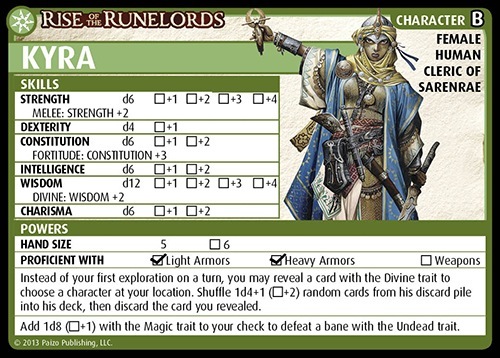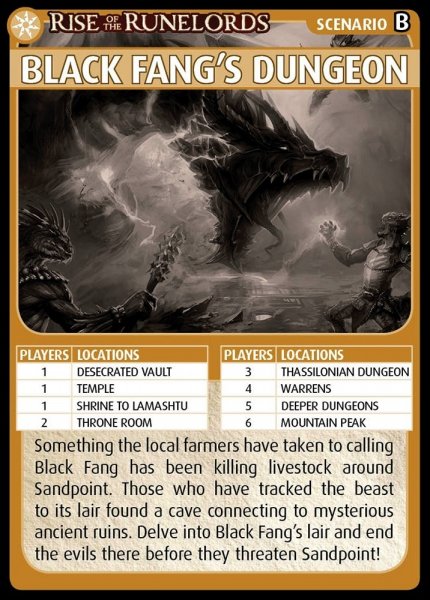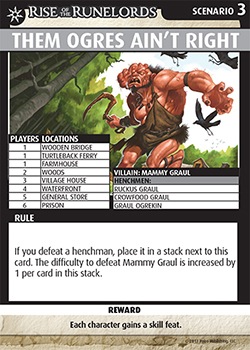

Once again, we come to an installment of Tabletop Co-Op, where we discuss the world of cooperative board and card games. This time around, we are taking a look at the Pathfinder Adventure Card Game, a co-op deckbuilding RPG hybrid. Go on a quest, fight the bad guys, and find new loot cards to shuffle into your deck for the next session in this unique and innovative card game.
Pathfinder is a fantasy RPG system, developed about a decade ago by Paizo. It is very similar to Dungeons & Dragons, with a ruleset heavily influenced by the third edition version of D&D. In the years since the radical changes of D&D 4th Edition, Pathfinder has become even more popular. The Pathfinder card game is set in the same universe as the RPG, and shares some mechanics with a heavy use of the RPG’s background elements.
The Pathfinder Adventure Card Game is, at its heart, a deckbuilding game. However, it is quite distinct from deckbuilders like Dominion and Legendary in that the changes in a player’s deck last from one game to the next. In Dominion, your small stack of starter cards grows quickly during the game. The cycle of purchasing new cards, adding them to your deck, and using them to purchase new cards goes by at a fast pace. At the end of the session, all the cards go back in the box. Most deckbuilding games follow this same basic scheme.

The Pathfinder Adventure Card Game changes this scheme up. In traditional RPGs, characters go on adventures, which over time form a campaign. Pathfinder follows this same structure but applies the deckbuilding mechanic. Instead of a character sheet, your character is represented by a deck of cards. When you first create characters, these decks are filled with “starter” cards, just like other deckbuilders. As characters go on adventures, they will find new loot, including spells, blessings, weapons, armor, and even henchmen. These are added to the player’s deck for the next game. Eventually, the starter cards will all be replaced. Over the space of several sessions, characters get more powerful, just as in an RPG. Representing the genre standard of a slow increase in character strength over time by using the deckbuilding mechanic is sheer brilliance and it works quite well in play.
“Adventure” is right there in the title, so as you might expect, there is a strong theme and an authentic RPG feel to the game. When you play, it feels very much like a session of classic D&D. You can sit down to play a one shot scenario, or work your way through a series of connected sessions which make up an adventure path. The base set for the Pathfinder Adventure Card Game is subtitled "Rise of the Runelords". This series of adventures is taken straight from the Pathfinder RPG. Players are rewarded by accomplishing goals set forth for the different parts of the adventure. The feeling of continuity is unique to deckbuilding games, and again, feels much like a traditional RPG in this way.


Let’s take a closer look at what a session of the game looks like. Players choose a character, and create their deck (if they haven’t already done so before). Each scenario consists of a set of locations, a group of monsters, and a villain or some other such final goal. Location decks are composed of boons and banes. Boons are weapons and other gear that help you, while banes are either monsters, traps, or other challenges to overcome. A timer deck is set up, forcing players to move quickly. Players choose a starting location, then the game begins.
On your turn, you can explore a location by drawing a card from the appropriate deck. Boons and banes are obtained or defeated by a skill check target system. Each character has a set of attributes, each tied to a particular type of die. A strong character might roll a d12 for that skill, while a weaker one might be stuck with a d4. By playing cards, you can effect the total roll by adding a set number to the roll, adding another die, etc. You might come upon a goblin, which requires a combat score of 8. A character might be able to roll a d6 for combat, add an offensive spell for an extra d10, use a henchmen to add 3 to the total, or all of the above. If the total is above 8, the goblin is defeated. Fallen foes go back in the box, while boons, if earned by a successful skill check, do into the player’s discard pile, typically to be used in the next session.
As is typical for the fantasy genre, cooperation and teamwork elements are very strong in the Pathfinder Adventure Card Game. Meeting the different challenges is a very complex puzzle. Working together to figure out the best locations for each character to explore, whether or not to work in individual locations or to pair up, and many other decisions all require planning. Players can play blessings upon each other to assist in meeting skill checks. Perhaps the greatest cooperative aspect comes after the scenario is completed. Players can trade cards with one another and add these new cards to their decks. So if the sorceress finds a magical axe, she can trade it to the fighter for that nifty spell he can’t really use. Sharing resources like this is one of the hallmarks of co-op.
The Pathfinder Adventure Card Game is a very impressive package. The genius of a slow-growing deckbuilder, and the appeal of the heavily thematic fantasy setting, make a compelling experience. More adventure paths will be released regularly, keeping the action fresh and adding more nifty cards for players to go questing for. If you enjoy deckbuilding games, or are a fan of Paizo’s flagship RPG, give Pathfinder a serious look.